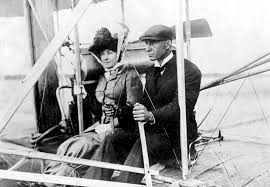The Wrights had competitors. In the US, motorcycle racer Glenn Curtis, Smithsonian director Samuel Langley, telephone inventor Alexander Graham Bell, and gadabout and sometime compatriot Augustus Herring, who flew for Octave Chanute. In France, Henri and brother
Maurice Farman, motor vehicle inventor
Louis Blériot, and Brazilian coffee heir Alberto Santos-Dumont were all making strides. Flashy Santos-Dumont had built a series of successful airships and used to fly them to restaurants in Paris, leaving them tied up outside like horses. There were also lesser known US competitors such as John Montgomery in Seattle and Gustave Whitehead in Bridgeport CT. What they all had in common is that they worked on the problems of lift and power, and neglected control and stability.
 |
| Bleriot V airplane, 1907 (note lack of control surfaces) |
The Wrights had taken a different approach. Perhaps coming from their experience as bicycle builders, they had approached control and stability as the primary issues, and solved lift and power along the way. After not flying during 1906 and 1907 and with their patent for wing-warping granted, the Wrights felt it was time to unveil their invention to the world.
The 2 year break in flying had done major damage to the Wright's reputation. By early 1908, Blériot in France and Curtiss in the USA had both managed to get off the ground and were setting official records, with Curtiss flying over 5,000 ft in a straight line to win a prize issued by Scientific America magazine in
June Bug, an airplane designed by Bell. Farman won 50,000 francs for a flight of first 1, and then 2 kilometers in a circle in January 1908 (his airplane didn't use banked turns, a large vertical rudder turned the aircraft in a large skidding turn like a boat on water). Never mind that 4 years earlier, the Wrights had already flown further, and in well controlled circles and figure eights too - they didn't enter the competitions. The feeling arose in the US that the Wrights were "liars - not fliers", and in France that they were
bluffeurs (fakes).
 |
| June Bug - designed by Alexander Graham Bell |
In the Spring of 1908, Wilbur took a ship to France, where an updated version of the 1905 Flyer III was awaiting him. The 1908 Flyer (Wright Model A) was larger still, with a 35 HP engine and two wicker seats replacing the old prone piloting position, with the controls modified to permit their use while sitting upright. During their hiatus, the Wrights had built seven Model A Flyers, with one later to be modified in 1909 to US Army specification #486 and renamed the Military Flyer.
The aircraft had been severely damaged during shipment and customs inspections in France, and Wilbur began work to repair it, an effort which took 3 months and didn't enhance his reputation at all in the French press - he was still clearly not flying.
 |
| Wright Model A (this a/c still exists and on display in the Deutsches Museum in Munich |
By August 8th, 1908 all was ready. Crowds gathered at the Hunaudières horse racing track near Le Mans, among them Blériot and other French pioneers and writers. Some expressed disdain at the Wrights use of a launch catapult, believing it was cheating, and others at the size of the Flyer, expecting that Wilbur would find it difficult to shift his weight fast enough to control the very large machine in the air.
The first flight lasted for only 1 minute 45 seconds, but was complete triumph. Launched towards some trees, initially the crowds thought they were about to witness a disaster, but without discernible effort, sitting still in his chair, Wilbur guided the aircraft smoothly into a banked, controlled turn, and then another, and another and finally landed where he had taken off. Rather than admit they were beaten, the French press declared the Wrights to be not Americans, but "Men of the World".
L'Aérophile
editor Georges Besançon wrote that the flights "have completely
dissipated all doubts. Not one of the former detractors of the Wrights dare question, today, the previous experiments of the men who were truly
the first to fly". French aviation promoter and Wright critic Ernest Archdeacon wrote, "For a long
time, the Wright brothers have been accused in Europe of bluff... They
are today hallowed in France, and I feel an intense pleasure...to make
amends."
Meanwhile 4 weeks later in the USA, Orville duplicated his brother's feat flying another Model A at Fort Myers VA, making the first flight over 1 hour on September 9th. 8 days later, carrying Army Lieutenant Thomas Selfridge, a propeller failure in flight led to the first fatal airplane crash. Selfridge was killed, and Orville badly hurt with multiple bone fractures. Katharine came to Virginia to help nurse him back to health, and he continued flying and setting records.
  |
| Flying Brothers - Orville flying the Model A at Ft Myers, Wilbur in Le Mans (with the maligned catapult) |
In France, Wilbur's fame climbed as he continued flying, carrying passengers including the first woman, Edith Berg, the wife of the brothers' European business agent Hart O. Berg. She tied her skirts together with rope to prevent them flying up in the slipstream, inadvertently creating the fashion of the moment, the "hobble skirt".
 |
| Edith Berg and Wilbur |
 |
| The "Hobble Skirt" |
In January 1909, Orville and Katharine joined Wilbur in France. They were suddenly the most famous 3 people in the world, and everyone wanted to be seen with them -“Princes and millionaires
are thick as fleas.” Wilbur wrote in letter home. They stood triumphant and vindicated.
 |
| Meeting King Edward VII of Great Britain, and King Alphonso VIII of Spain |
|






















